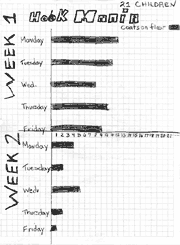Stuff that works: Project Ideas
Hook Mania
Hook Mania
Classroom procedures that are not working well are starting points for Designed Environment projects that deal with procedures. All you need for such a project is to be sensitive to a situation that is not working, and then involve the students in finding the solution. Tonia Bailey, a third grade teacher, did several Designed Environments projects. Here is one of her classroom problems:
The children ’s coats often wind up on the floor of the closet. When this occurs, the coats get dirty, the doors cannot be closed, and the room looks disorganized.
As she worked on Designed Environments projects, Tonia developed an approach that worked well for her and her students. She had a small group of students do the initial analysis of the problem that they then shared with the rest of the class. From that point on it became a class project. Tonia tells how this worked with the “Hook Mania” project.
Coats on the Floor
Problem: The children’s coats are getting dirty because they are thrown in the closet.
Solutions:
FIGURE 1: One group’s proposed solutions to the coat problem
I gathered four children to consider a problem: the coats that belong to the children are often thrown on the floor of the closet. When this occurs, the doors cannot be closed, and the room looks disorganized. The four children had the task of counting the coats on the floor in the morning after the children unpacked and began their day. The group charted the number of coats for five days (Monday-Friday).
They presented their data to the class. The children had a brainstorming session where they listed possible solutions. They were to discuss the solutions and list the ways they would solve the problem.
The groups varied in their solutions (see Figure 1 for one group ’s solutions) and the class had difficulty determining which solution they would try first. I had to explain that only one solution can be tried out at a time. I let children explore possible solutions even if it seemed to me they would fail. I discouraged solutions which directly involved me (e.g., detention, keeping children upstairs. etc.)

FIGURE 2: Number of coats on floor before (Week 1) and after (Week 2) hooks were numbered
The children decided to put a number next to each hook. Every child received a hook number (alphabetical order).The data was collected again for five days, Monday through Friday. The results are seen in Figure 2.
The graph of “Hook Mania” (see Figure 2) shows a marked decrease in coats on the floor after children had become aware of this as a problem and after they had designed their own solution. The results underline how important it is to have children collect and represent real data – data that represent their own behavior. Such data are a major impetus for changing behavior.